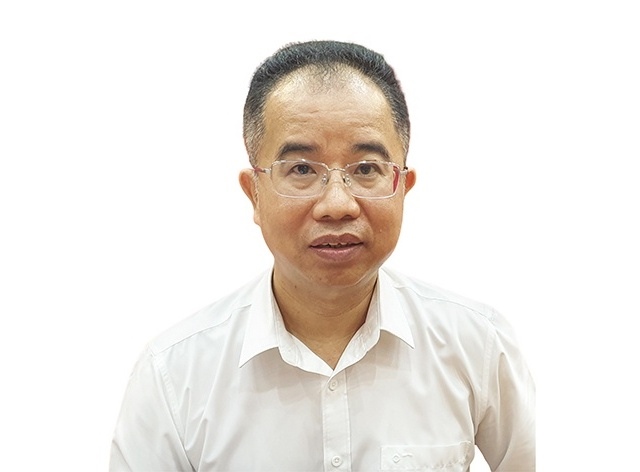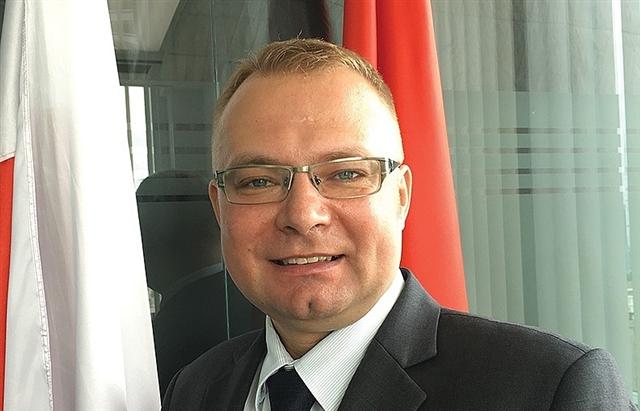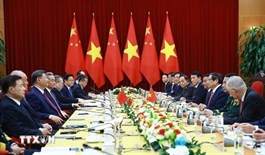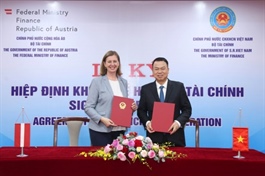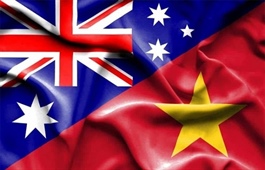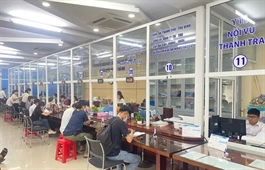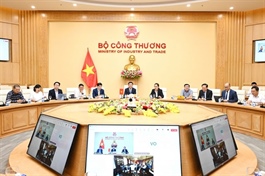ASEAN seeks to broaden trade outlook
ASEAN seeks to broaden trade outlook
ASEAN is bolstering intra-bloc trade and fostering fair markets where non-tariff barriers are set to be trimmed, in which Vietnam is strengthening links with regional peers.
At the end of May, ASEAN leaders adopted the ASEAN Economic Community Strategic Plan 2026–2030. One of the strategic goals of the plan is to realise an integrated single market and production base with new sources of competitiveness, in which bolstering intra-ASEAN trade in goods counts most, requiring successfully integrating emerging and advanced technologies into regional trade networks while strategically revisiting competitive sectors.

New and upgraded ASEAN frameworks aim to support small businesses, enhance customs processes, and much more, Photo: Shutterstock |
This includes embracing trade-related new and emerging issues, advancing sustainable development objectives such as environmental sustainability, supporting the expanding number of micro- and small- and medium-sized enterprises, and harnessing rapid technological transformation.
“This will strengthen regional procedures and practices in minimising negative impacts of barrier elements in non-tariff measures, enhance the use of available mechanisms to resolve trade disputes, and intensify efforts to enhance efficiency of customs processes across the region,” stated the plan, revealed earlier in June.
Currently, non-tariff barriers are significant obstacles to trade within ASEAN, often as impactful as tariffs. They cover many measures restricting trade without directly imposing tariffs, including regulations, standards, and other trade-related policies.
According to the ASEAN Secretariat, many other measures are also being advanced, such as enhancing intra-ASEAN trade through effective implementation of the ASEAN Trade in Goods Agreement (ATIGA) and its subsequent upgrades, taking into account new and emerging issues relevant to post-2025 environment.
“It is necessary to strengthen trade facilitation by enhancing transparency mechanisms, procedures, and practices, as well as minimising the negative impacts of the barrier elements in non-tariff measures,” the Secretariat stated.
Export restrictions continue to be a challenge for advancing such trade, which has remained largely stagnant for many years. Intra-ASEAN trade currently makes up just 21.2 per cent of the region’s total trade last year, falling far behind other blocs like the EU, which sees an intra-trade level of 60 per cent.
At present, one of the largest priorities of ASEAN is to conclude negotiations for the ATIGA upgrade. The second protocol to upgrade the ATIGA is expected to be signed in November during the 47th ASEAN Summit organised in Malaysia.
The upgrade is also expected to help the bloc woo more investment. The ASEAN Secretariat reported that in 2023, ASEAN recorded $230 billion in foreign direct investment inflows, with Singapore ($159.6 billion), Indonesia ($21.6 billion), and Vietnam ($18.5 billion) as top destinations. Strengthening regional supply chains and easing business regulations will further promote ASEAN’s attractiveness to investors.
Leaders also aim to foster fair markets in the region in order to enable businesses to compete on a level playing field, within a transparent, equitable, and conducive ecosystem.
“Fostering fair markets not only promotes entrepreneurship and enhances innovation, but also attracts foreign investment and improves the region’s global competitiveness and resilience,” said a report on the strategic plan. “This requires robust competition regimes and effective enforcement which will cultivate a competitive culture and achieve sustainable, inclusive, and resilient growth.”
In ASEAN’s vision, fair competition benefits various stakeholders across member states, leading to lower prices and improved product quality. “To effectively enforce laws, competition authorities must also cooperate and coordinate to instil trust and stability in regional markets. Strong national competition policies and laws are critical for creating a robust regional market, ensuring that competition principles are seamlessly integrated into regional and domestic economic policies,” the report read.
|
Conference: EASING NON-TARIFF BARRIERS TO UNLOCK ASEAN’S POTENTIAL Vietnam Investment Review under the Ministry of Finance, in cooperation with the Embassy of New Zealand in Vietnam, is to hold a conference on non-tariff barriers and advancing practical solutions to promote regional economic integration. . Time: 8:30-11:30am, June 27, 2025 . Venue: 47 Quan Thanh street, Ba Dinh district, Hanoi . Content: The conference aims to share real-world insights on non-tariff barriers, propose policy recommendations, and support ASEAN governments in shaping trade strategies and engaging with the United States It will also foster business networking and equip companies to stay competitive amid global trade shifts. . Speakers: policymakers, business leaders, and international partners. . Guests: Around 100 participants are expected, including officials, ASEAN trade representatives in Hanoi, and local and regional businesses. . Media: Local media and TV channels. Coverage will appear in printed and online for Vietnam Investment Review and Bao Dau tu (vir.com.vn and baodautu.vn). To register through email: [email protected] (Please include name, title, organisation, email address, and phone number) before June 26, 2025. |
Top grower
To facilitate intra-trade and investment inflows, the region is boosting the construction of the ASEAN Power Grid amid the bloc’s electricity demand forecasted to grow by 2.6 times until 2050, with total capacity of 1.6TW.
With an initial investment of $350 billion, it was reported last week that if completed, the grid can create $3 trillion worth of additional GDP to the region’s economy by 2040. Over 1.45 million direct and indirect jobs will also be created, with 75 per cent of employment related to renewable energy and green technology.
At the 46th ASEAN Summit held in Malaysia in late May, it was reported that in defiance of external challenges and global investment and trade risks, Vietnam will continue to be the fastest-growing economy in ASEAN, and it is becoming an increasingly attractive to global investors including many from ASEAN, with the country’s trade with other member states kept augmenting.
Under FocusEconomics’ projections, Vietnam’s economy will grow 6.1 and 6 per cent in 2025 and 2026, respectively – far higher than the predicted 4.1 and 4.2 per cent, respectively for the whole region, and also much higher than those of the other nine member states.
“The Vietnamese economy is expected to remain one of ASEAN’s fastest-growing, supported by upbeat private and public consumption,” FocusEconomics said.
According to Vietnam’s National Statistics Office, Vietnam’s bilateral trade with regional nations reached $83.9 billion in 2024, with the country suffering from a $9.9 billion trade deficit. Vietnam’s export turnover from ASEAN member states stood at $37 billion, up 13.7 per cent on-year, and the country’s import turnover hit $46.9 billion, up 14.7 per cent on-year,
In the first five months of 2025, the bilateral trade stood at $38.1 billion, with Vietnam’s exports of $15.8 billion, and imports worth $22.3 billion. This means a trade deficit of $6.5 billion. The ASEAN is Vietnam’s third-largest trade partner.
Vietnam’s government is actively working on strategic initiatives to strengthen bilateral trade with individual ASEAN nations. With Singapore, a focus is placed on digital transformation, clean energy, and evolving Vietnam-Singapore Industrial Parks into smart, green, and sustainable zones.
For Thailand, a stress is laid on increasing trade to $25 billion via balanced trade structures and cooperation in supply chains, tourism, and the green economy. Malaysia is another key partner, with Vietnam targeting $20 billion by 2030 in trade by cutting trade barriers, easing Halal certification, and promoting imports of Vietnamese Halal products.
Similar strategies are in place with Indonesia and the Philippines, aiming to raise trade volumes and broaden investment in emerging sectors.
Wooing investment
Vietnam’s trade and investment cooperation with ASEAN countries has become a cornerstone of its economic strategy, contributing significantly to regional integration and growth. The ASEAN Secretariat has commended Vietnam’s investment facilitation, which will help lure in more investment both inside and outside the region.
“Vietnam has allowed complete foreign investment in insurance and set implementation guidelines for the 2020 Law on Investment, which includes a restrictive list for market access for foreign investors,” it stated, adding that the Vietnamese government has also continued to further improve the country’s investment environment for investors.
According to the Vietnamese Ministry of Finance’s Foreign Investment Agency, cumulatively as of late May, ASEAN nations have poured a great deal of investment into Vietnam, including Singapore with total registered capital of $86.23 billion, followed by Thailand ($14.87 billion), Malaysia ($14.56 billion), Brunei ($1 billion), Indonesia ($670 million), the Philippines ($624.8 million), Laos ($102.5 million), and Cambodia ($77.4 million).
At a recent dialogue with ASEAN businesses, Prime Minister Pham Minh Chinh highlighted Vietnam’s commitment to fostering an environment conducive to business growth. He stressed institutional reform, infrastructure development, and human resource training as critical to sustainable operations.
These enterprises are increasingly looking to boost investments in Vietnam’s key sectors, including high technology, semiconductors, AI, aviation, energy, agriculture, finance, and logistics. Such investments enhance Vietnam’s supply chains and contribute to the country’s ambitions of achieving 8 per cent economic growth or more in 2025.
According to the ASEAN Secretariat, Vietnam is now among the largest foreign investment attractors in the region. In Vietnam currently, manufacturing remained the largest recipient ($316.7 billion as of late May), followed by real estate ($78.2 billion) and electricity generation ($42 billion).
Energy remains a bright spot, with large projects including the $2 billion Thai Binh liquefied natural gas power plant by a consortium involving Tokyo Gas and Kyunden (both Japan), a $1.5 billion photovoltaic cell production project by Jinko Solar (China) and a $1.1 billion electronic component manufacturing facility by LG Innotek (South Korea).
- 09:18 25/06/2025


